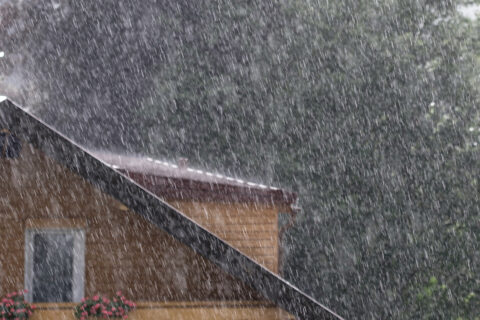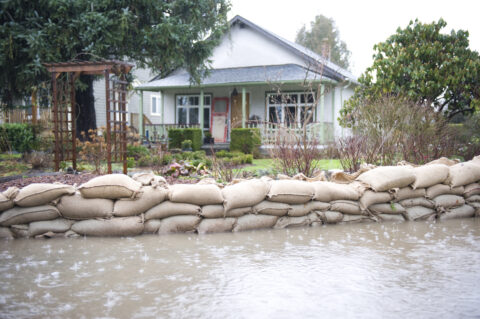
Here are 10 steps to take now to reduce storm damage this spring.
Inspect and Repair the Roof
Before the start of the rainy season in mid-March, take some time to inspect your roof. Look for any wind damage to the roof and make sure all your chimneys for the furnace, water heater, and other appliances are properly hooded.
Take advantage of a warm, clear day to get up on the roof, but also inspect the roof from inside your house, getting into the attic to look for signs of leaking. Do this on a dry day to look for signs of ongoing leaks, such as mold and mildew. Then perform an inspection on a rainy day to see if there is any new water infiltration.
Prepare Gutters and Downspouts
While you’re up on your roof, remove all leaves and other debris from your gutters. Check for leaks in the gutters and make sure that the gutters slope toward the downspouts.
Make sure the downspouts are clear. If they tend to get clogged with leaves, use something to block leaves and other debris from getting into the downspouts. Direct the downspouts far from your foundation to avoid damage to your home.
Check Seals on Windows and Doors
Your windows and doors can let in a lot of water if they’re not properly sealed. Check all the weather stripping to make sure it’s not worn out and replace it if necessary. Check the caulk around all your windows and door frames to make sure it’s still in good shape – this can degrade over time, especially for windows and doors in direct sunlight.
If you have window wells, get covers that seal properly to help avoid water pooling in them.
Look for Landscaping Problems
There are many things in your landscaping that can cause problems in heavy rain. First, make sure all the trees on your property, especially those near your house, are healthy and strong enough to survive a heavy storm. Watch for branches that might break off and trees that could fall down in a strong wind. In addition to the branches, check the roots. The roots should be healthy, without a lot of erosion around the tree.
Make sure your yard is designed to direct water away from your house, preferably into storm drains or drainage ditches.
Lock Up or Tie Down Loose Items

Anything that can wash or blow away should be brought inside a secure structure or anchored firmly.
Secure Fuel Tanks
In addition to any other loose items in your yard, make sure all your fuel tanks are secured. If you have a propane or fuel oil tank outside your home, make sure it’s sufficiently secured to avoid washing away.
Also secure any fuel tanks you have in your home, whether they’re in the basement or ground floor. If you get flooding, the tanks can break off and release their contents into the water or air.
Check Your Sump Pump
If you have a sump pump, make sure it is functioning properly. Put some water in the sump and make sure the pump can clear it reasonably quickly. See where the drainage from the pump goes. It should be far from the house and direct water so it will easily drain off the property.
Check Your Electrical Outlets
Electrical wiring can be badly damaged by flooding. It can even be dangerous. Recommendations are that all outlets and wiring should be a full foot above the flood line. If you have outlets likely to be compromised, get a licensed electrician to relocate them. If you can’t get them relocated in time, be ready to safely shut off the power if any outlets get flooded.
Elevate Vulnerable Items and Appliances
Don’t leave appliances and valuable items on the ground where they can be damaged easily by flooding. Instead, get your furnace, water heater, dryer, or other appliances off the ground. Typically, it’s recommended that you elevate them by at least a foot. Don’t store irreplaceable items like photographs on the ground on the main level or in the basement. Move them off the floor but also consider moving them up to a higher level. Transfer them from cardboard boxes into plastic totes with good seals.
Prepare to Block Flood Waters

Help with Water Damage in your area
Even if you take all these steps, there will likely be situations where you might still experience water damage in your home. When this happens, you need a storm damage restoration expert who can eliminate the lingering danger of water damage, such as a weakened house structure and mold growth to restore your house to its original condition. your local FLEET company has been the leading restoration company in your area since 1954. We have extensive experience dealing with water damage and other major storm damage to houses and businesses. We offer 24/7 emergency response services, so we can be out to help with water damage immediately.
We also handle every step in the storm damage restoration process, including:
- Safety inspections
- Property board-up
- Demolition
- Debris removal
- Content restoration
- Water damage repair
- Mold remediation
- Final finishing touches
Think we might not be able to handle your property’s needs? Call and ask.
In addition, your local FLEET company knows how to deal with insurance. This might be your first major insurance claim, but it’s not ours. We know how to talk to your adjuster, read your policy, and document both the damage and any repairs. Flood damage isn’t always covered, but if you are covered, our thorough process can help you get payment quickly and in the full amount of your coverage.
Please contact us today at 844-967-4911 for help with storm damage in your area.
